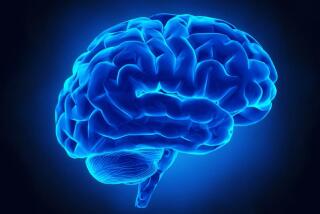For Alzheimer’s Patients, Help Is Too Little, Too Late
- Share via
It is a disease that is diagnosed only after symptoms such as memory loss and disorientation have become undeniable.
By then, much irreversible damage has been done to the brain.
Typically, its patients are dead within four to eight years after the diagnosis, although some live as long as 25 years.
And for now there is only one conclusive test to show that it ever existed: an autopsy.
Only in death is the Alzheimer’s-ravaged brain, shrunken and shriveled by a mass suicide of its cells, revealed. For the elderly, the odds are about one in five of developing some form of dementia.
Still, Carl Cotman, director of UC Irvine’s Institute for Brain Aging and Dementia, continues in his fight to battle Alzheimer’s disease.
*
Even though genes have been found that seem related to Alzheimer’s, they do not necessarily doom a person to the disease. They indicate only that the people who carry them, about 4% of the population, are at five times greater risk. Many people with the genes never develop the disease, and 40% of Alzheimer’s victims do not have the high-risk genes.
This lack of a medical test is the sorest point in Alzheimer’s treatment. A prescription drug, commercially known as Cognex, can lessen Alzheimer’s symptoms in about 30% of cases, and many more drugs are becoming available. But until a reliable diagnostic test is developed, the disease cannot be targeted at its earliest, symptom-free stages, when drugs would do the most good.
The root of the problem is that unlike other organs, the brain is isolated, physically and chemically, and cannot be probed for tissue or fluid samples. Encased in bony armor and walled off by the so-called blood-brain barrier, few of its chemical byproducts leak out. So far, those that do have not proved useful for diagnosis.
“Various people are working on a blood or spinal fluid test for Alzheimer’s,” says Neil Buckholtz, head of Alzheimer’s research at the National Institute on Aging in Bethesda, Md. “Theoretically, there have to be markers--things going on in the body that could be detected and measured.”
Meanwhile, researchers concentrate on learning just how the disease evolves and does its damage. Most researchers believe the disease is at work many years, perhaps decades, before symptoms become obvious.
“I’m very optimistic that within the next five or 10 years we will have a much better understanding of the process,” Buckholtz says. “I think there are eventually going to be some tests, but it’s not clear what they will be.”
Much progress has been made in the last 10 years. Before then, “senility” was popularly believed to be a natural part of growing old. Alzheimer’s disease, first diagnosed in 1907, was considered to be quite rare.
Now researchers believe that except for a slowing of brain processes, aging does not necessarily degrade the brain. Dementia is abnormal, usually caused by disease.
Alzheimer’s is the cause of half of all dementia and is a contributor in another one-fourth of all cases, researchers estimate. They believe there are more than 4.1 million cases of Alzheimer’s in America today, and as the population ages along with the baby boomers, the total is expected to rise dramatically.
Because dementia is at times so difficult to diagnose, the risks of developing it are very rough estimates. Malcolm B. Dick, a psychologist who diagnoses dementia at the UC Irvine Alzheimer’s clinic, says the risk between ages 65 and 74 is 3% to 10%. The risk about doubles for each additional decade of life, he says. Some estimate it reaches nearly 50% by age 85.
The more than 60 other causes of memory defects--among them depression, thyroid malfunction and vitamin B-12 deficiency--are less common, and in some cases their effects are reversible.
The damage caused by Alzheimer’s, however, is permanent. Driven by a process that is only partially understood, brain cells simply begin dying. By the time the victim dies, the brain has shrunk to about two-thirds its normal size.
Researchers generally agree that brain cells, which do not divide and therefore cannot be replaced, are tricked into committing suicide.
This self-destruction process, called apoptosis, is built into all cells and is normally triggered only to rid the body of defective or unwanted cells. But in Alzheimer’s, a false signal may be given to start a mass suicide in the brain that spans decades and eventually kills its victim. Researchers believe the signal probably comes from an imbalance or concentration of substances that occur normally in the brain.
The disease attacks the parts of the brain involved in memory, language and reasoning. Eventually its victims cannot recognize friends or even family, cannot remember what was done or said a few minutes ago, have difficulty forming and understanding sentences, and can become lost only a few yards from home. Personality and behavior are affected as well. Judgment becomes somewhat, then utterly, irrational.
Who is afflicted and who is spared seem to be decided by a combination of genetic and lifestyle factors, Cotman says.
“If you had a head injury and lost consciousness and you’re carrying the wrong genes, the likelihood you’re going to get dementia goes up tenfold,” Cotman says. This makes prizefighting “the craziest profession in the world,” he says.
There are protective factors as well, Cotman says. “Formal education turns out to be one of them. It’s very clear. Some people say that additional education and training enriches the circuitry in the brain, so when the little losses start to occur, you don’t go down so far because you’re starting from a higher point.”
*
Strenuous exercise such as running produces substances in the brain that are known to benefit brain cells, Cotman says.
Other supposed protective factors have downsides, however.
Vitamin E may counteract Alzheimer’s, but only in doses much higher than the usual vitamin supplements. Such high doses can be toxic to some people.
Likewise, tests in women suggest that taking estrogen may inhibit Alzheimer’s but may increase the risk of breast cancer. “For elderly people, the benefits probably outweigh the risks,” Cotman says.
Such treatment is moot, however, if diagnosis comes too late.
Dick says that when symptoms suggesting Alzheimer’s appear, many people deny that anything is wrong or attribute these changes to normal aging. Many wait to seek help until symptoms are so obvious they’re undeniable, typically a three- to four-year delay.
Even then, diagnosis is difficult. The disease is detected not by specifically identifying it but by eliminating all other likely causes.
A physical examination looks specifically for evidence of small strokes that the patient may not even realize occurred. Strokes alone or in combination with Alzheimer’s can cause dementia.
A series of neuro-psychological tests are administered to determine which mental skills are intact and which are impaired.
Finally, patients are sent for brain scans, which can reveal evidence of strokes and unusual gaps in the brain, presumably where brain cells have died and their space filled by spinal fluid.
At present, brain imaging is far from conclusive, Dick says. People in the early stages of Alzheimer’s can show brain scans that appear entirely normal.
But Buckholtz says advances in brain imaging are the best hope for early diagnosis in the near future.
Cotman says he is optimistic that Alzheimer’s will be controlled, if not cured. Research is moving at a fast pace, he says.
“It’s a tough problem, but it gets simpler all the time. It is solvable--that I’m convinced of. We just have to get at it early enough.”






